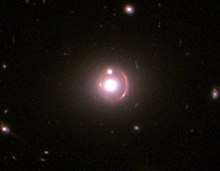9Spitch
9Spitch is a gravitationally lensed system of two galaxies. The nearer galaxy is approximately 2 billion light-years (610 Mpc) from Earth and is designated SDSS J020941.27+001558.4, while the lensed galaxy is 10 billion light-years (3.1 Gpc) distant and is designated ASW0009io9 (shortened to 9io9).[2][3] It was discovered in January 2014 by Zbigniew "Zbish" Chetnik, an amateur astronomer from Northamptonshire, England, while classifying images on the website Spacewarps.org.[2] The discovery was announced on the BBC television programme Stargazing Live.[2][3]
| 9Spitch | |
|---|---|
 | |
| Observation data | |
| Constellation | Cetus |
| Right ascension | 02h 09m 41.27s[1] |
| Declination | +00° 15′ 58.48″[1] |
| Redshift | 0.202±0.00006[1] |
| Helio radial velocity | 249.1 ± 17.7 km/s (154.8 ± 11.0 mi/s)[1] |
| Distance | 2 and 10 Gly (610 and 3,070 Mpc) |
The term Spitch comes from Chetnik's nickname Zbish, after a BBC producer misheard his nickname.
Observations
The Red Radio Ring (RRR) was discovered by four independent groups, including the Space Warps project using deep images from the Canada–France–Hawaii Telescope,[3] a cross-match with Herschel-SPIRE and Planck images at 350 μm to identify strongly lensed dusty star-forming galaxies (DSFGs) and follow up with Large Millimeter Telescope,[4] a detection with Herschel-SPIRE 500 μm images to identify strongly lensed DSFGs,[5] and identification of 9Spitch as the strongest lensed DSFG in the 278 GHz maps from the Atacama Cosmology Telescope (ACT) and follow-up with the Green Bank Telescope.[6]
The galaxy was studied with the Large Millimetre Telescope, which detected carbon monoxide in the lensed galaxy, and the Subaru Telescope, which detected different spectroscopic lines associated with star formation in the lensed galaxy. This study suggests a high star forming rate of about 2500 Mʘ yr −1 or a thousand times the star forming rate of the Milky Way. In the paper the name 9io9 is used instead of 9Spitch. The source reconstruction supports a compact core and an extended region, maybe indicative of a jet or lobe coming from an active galactic nucleus (AGN). The galaxy might be in the center of a large galaxy group or cluster and it will likely evolve into a massive elliptical galaxy.[3]
Observations with the Northern Extended Millimeter Array (NOEMA) and detailed reconstruction of the lensed galaxy suggests an approximately 3-kiloparsec (9,800 ly) diameter rotating disk of gas.[7]
9Spitch was observed with the Atacama Large Millimeter Array (ALMA) 12-meter antennas in December 2017 as part of project 2017.1.00814.S. The data revealed the presence of atomic carbon and carbon monoxide as a tracer of star formation. It was estimated that the total star formation rate of the molecular ring is about 2800 M☉ yr−1. ALMA also detected the cyanide radical travelling twice the velocity of the rotation of the molecular ring, with a radial velocity of 680 km s−1. This is explained as a possible interaction between material outflowing from the AGN and interstellar material.[8]
Harrington et al. (2019) reports four independent detections of the Red Radio Ring, including the detection with Space Warps. In their paper they report new Atacama Pathfinder Experiment (APEX) observations, presenting the detection of nitrogen [N II] 205 μm. The velocity structure of the nitrogen is similar to carbon monoxide and they concluded that both share the same volume. The ratio of the nitrogen luminosity and the infrared luminosity resembles more a normal star-forming galaxy and less a galaxy with star-formation influenced by a quasar.[9]
References
- "SDSS J020941.27+001558.4". Sloan Digital Sky Survey. Retrieved 19 January 2015.
- "Daily Fail". Zooniverse.org. 17 January 2014. Retrieved 19 January 2015.
- Geach, J. E.; et al. (September 2015). "The Red Radio Ring: a gravitationally lensed hyperluminous infrared radio galaxy at z = 2.553 discovered through the citizen science project Space Warps". Monthly Notices of the Royal Astronomical Society. 452 (1): 502–510. arXiv:1503.05824. Bibcode:2015MNRAS.452..502G. doi:10.1093/mnras/stv1243.
- Harrington, K. C.; et al. (June 2016). "Early Science with the Large Millimeter Telescope: Observations of Extremely Luminous High-z Sources Identified by Planck". Monthly Notices of the Royal Astronomical Society. 458 (4): 4383–4399. arXiv:1603.05622. Bibcode:2016MNRAS.458.4383H. doi:10.1093/mnras/stw614.
- Nayyeri, H.; et al. (May 2016). "Candidate Gravitationally Lensed Dusty Star-forming Galaxies in the Herschel Wide Area Surveys". The Astrophysical Journal. 823 (1). 17. arXiv:1601.03401. Bibcode:2016ApJ...823...17N. doi:10.3847/0004-637X/823/1/17.
- Su, T.; et al. (January 2017). "On the redshift distribution and physical properties of ACT-selected DSFGs". Monthly Notices of the Royal Astronomical Society. 464 (1): 968–984. arXiv:1511.06770. Bibcode:2017MNRAS.464..968S. doi:10.1093/mnras/stw2334.
- Rivera, Jesus; et al. (July 2019). "The Atacama Cosmology Telescope: CO(J = 3 – 2) Mapping and Lens Modeling of an ACT-selected Dusty Star-forming Galaxy". The Astrophysical Journal. 879 (2). 95. arXiv:1807.08895. Bibcode:2019ApJ...879...95R. doi:10.3847/1538-4357/ab264b.
- Geach, J. E.; et al. (October 2018). "A Magnified View of Circumnuclear Star Formation and Feedback around an Active Galactic Nucleus at z = 2.6". The Astrophysical Journal. 866 (1). L12. arXiv:1807.03313. Bibcode:2018ApJ...866L..12G. doi:10.3847/2041-8213/aae375.
- Harrington, Kevin C.; et al. (September 2019). "The 'Red Radio Ring': ionized and molecular gas in a starburst/active galactic nucleus at z ∼ 2.55". Monthly Notices of the Royal Astronomical Society. 488 (2): 1489–1500. arXiv:1906.09656. Bibcode:2019MNRAS.488.1489H. doi:10.1093/mnras/stz1740.
External links
- ASW0009io9 record at Spacewarps.org
- ASW0009io9 at SIMBAD
- 9Spitch on WikiSky: DSS2, SDSS, GALEX, IRAS, Hydrogen α, X-Ray, Astrophoto, Sky Map, Articles and images